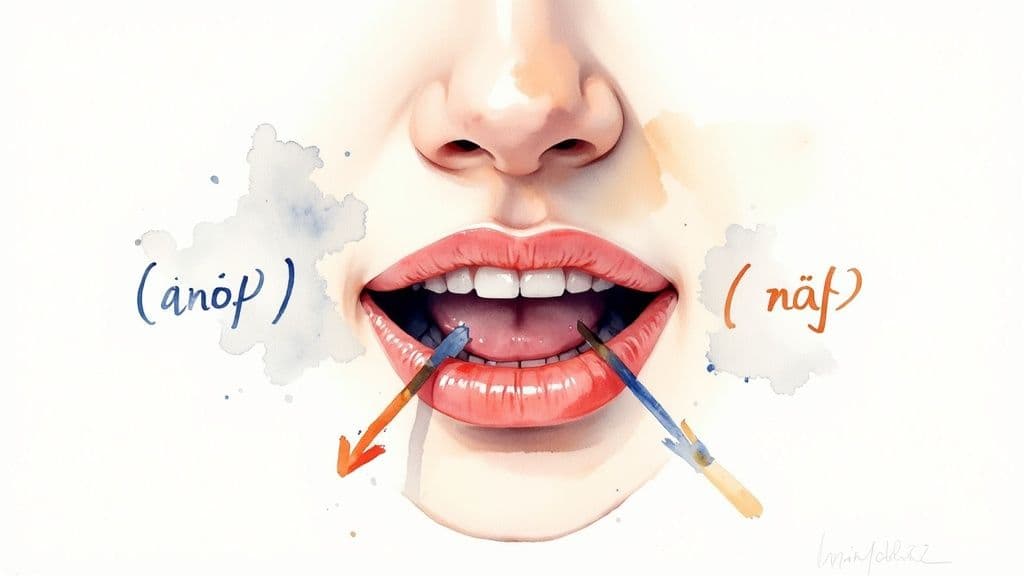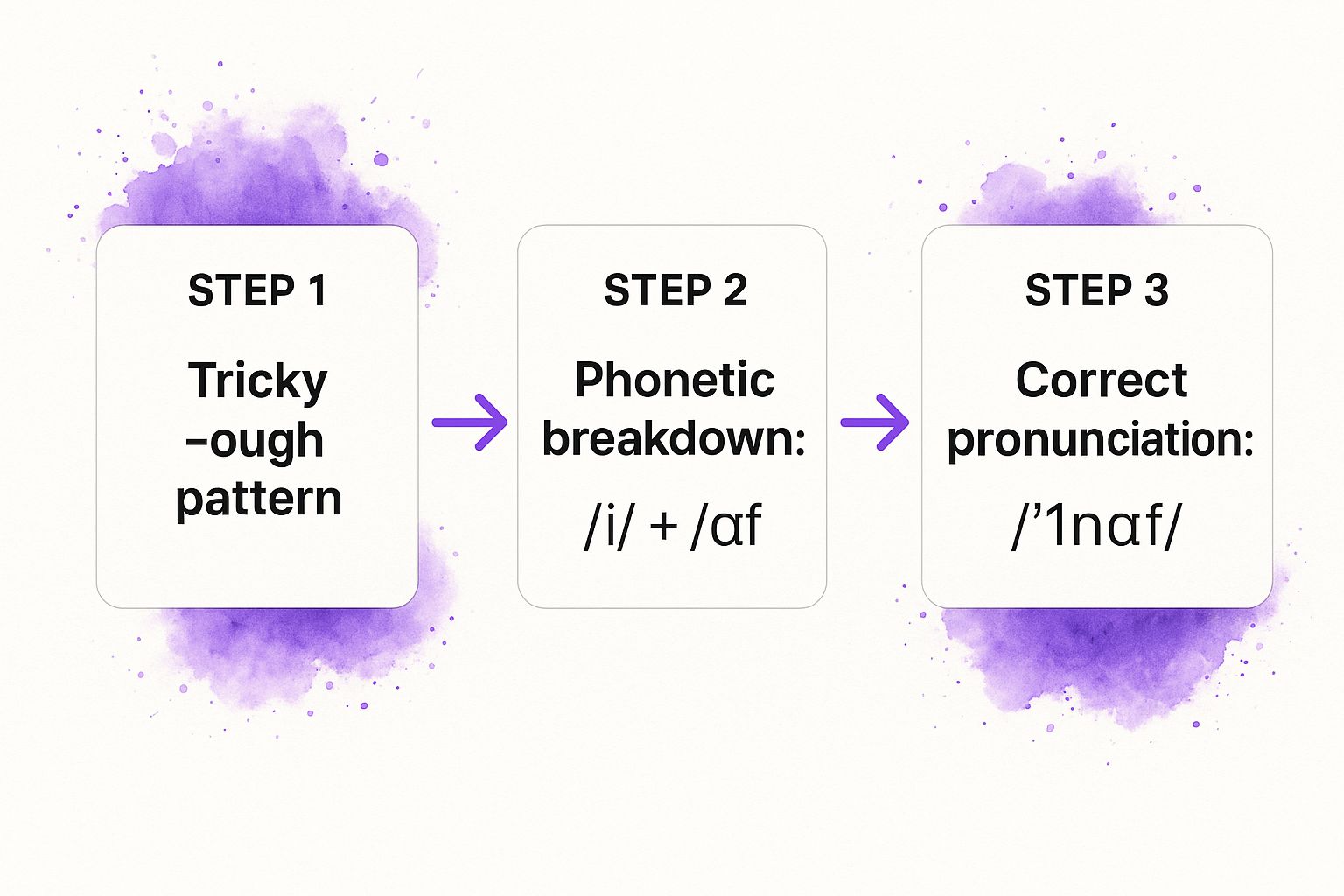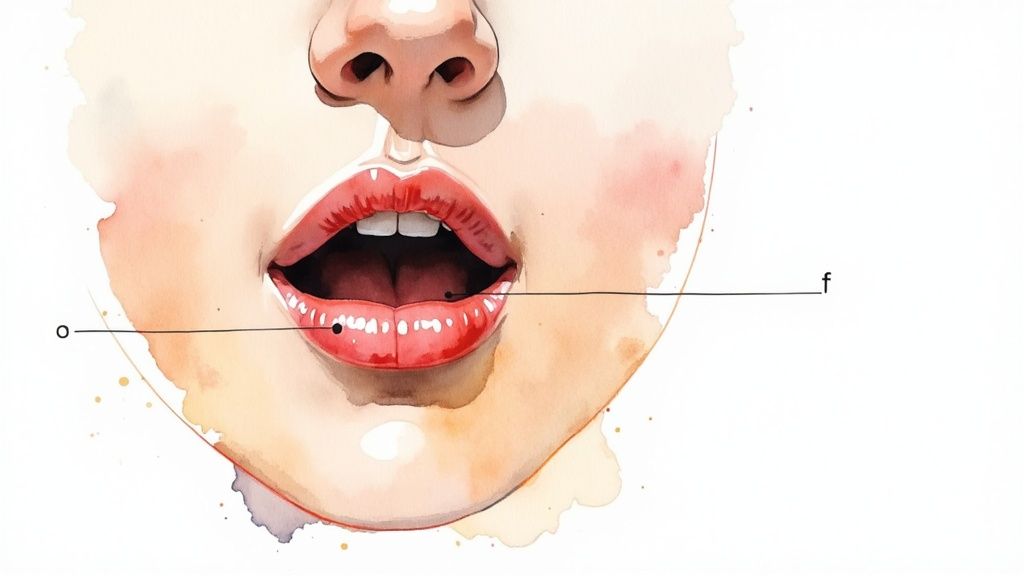Master the Pronunciation of Enough
Tired of stumbling over the pronunciation of enough? Our guide breaks down the sounds, mouth positions, and common mistakes to help you speak with confidence.


The real secret to pronouncing 'enough' correctly lies in its phonetic spelling: /ɪˈnʌf/. That tricky "-ough" at the end? It's not what it looks like. Forget the complex letters and just think of it as a simple /ʌf/ sound, just like in "rough" or "tough."
Why 'Enough' Trips Up So Many English Learners
Let's be real—the spelling of 'enough' is one of the most notorious troublemakers in the English language. That four-letter combination, "o-u-g-h," is a puzzle for almost everyone starting out. It can be pronounced in at least 10 different ways, showing up in words like through, bough, and cough. It’s this wild inconsistency that makes 'enough' such a common hurdle.
The word’s history also gives us some clues. It comes from the Old English ġenōg, which has cousins in German (genug) and Dutch (genoeg). While its meaning hasn't changed much over the centuries, the pronunciation certainly has.
This infographic breaks down the simple path from its confusing spelling to its actual sound.

As you can see, mastering the word is all about understanding its phonetic parts, not getting bogged down by the spelling.
Getting the Sound Structure Right
So, what’s the trick? It's all about breaking the word down into its two simple syllables: "e-" and "-nough."
Here's a quick reference table to help you visualize the sounds.
Phonetic Breakdown of Enough /ɪˈnʌf/
| Syllable | IPA Symbol | Sound Description | Example Word |
|---|---|---|---|
| e- | /ɪ/ | A short, relaxed vowel, like the "i" in "sit." | in, sit |
| -nough | /nʌf/ | Starts with the /n/ sound, followed by the vowel /ʌ/ (like in "cup") and the consonant /f/. | stuff, ruff |
This breakdown shows just how straightforward the sounds are once you move past the letters.
Expert Tip: The biggest mistake I see learners make is trying to pronounce each letter in "-ough" one by one. Don't do it! Just think of that whole chunk as a single sound unit: /ʌf/. Once that clicks, the word becomes so much easier to say.
Nailing these individual sounds is a huge part of sounding more natural and confident. Focusing on specific phonetic patterns like this one is a practical, effective way to improve. If you want to dive deeper into this, check out our guide on how to learn an English accent.
Nailing Each Sound in 'Enough'
Alright, let's roll up our sleeves and really break down how to pronounce 'enough', piece by piece. Think of it less like a single word and more like a combination of specific sounds. We'll start with the first syllable, 'e-', and then tackle the second, '-nough'.

It’s like building something with LEGOs. Each sound is a block. Once you know how to shape each block, putting them together correctly is easy. Let's get started with that first, often mispronounced, sound.
The First Syllable 'e-' as /ɪ/
The word 'enough' kicks off with an unstressed syllable, 'e-', which makes the short /ɪ/ sound. This is the exact same quick, relaxed vowel you hear in words like "it," "in," and "sit."
A common mistake I see learners make is pronouncing this with a long "ee" sound, like in the word "eat." The correct sound is much shorter and requires almost no effort. Try to say the word "it" but only voice the vowel. That's the relaxed sound you're going for.
Key Takeaway: The first sound is a short, relaxed /ɪ/, not a long, tense /iː/. To get it right, keep your jaw and tongue completely loose. This tiny change makes a huge difference in how natural you sound.
Getting this first syllable right is half the battle. It perfectly sets up the stressed second syllable that follows. Now, let’s get into the trickier part.
The Second Syllable '-nough' as /nʌf/
The second syllable, '-nough', is where the emphasis lies. It’s made up of two distinct sounds after the initial /n/. Let's pull them apart to make it more manageable.
First up is the /ʌ/ vowel sound. This is the classic "uh" sound you'll find in words like "cup," "luck," and "sun." Your tongue should be in a neutral, central position in your mouth—not high, not low, just relaxed. A good tip is to avoid rounding your lips; they should stay neutral, almost like you’re just opening your mouth slightly to speak.
After that vowel, we hit the final sound: /f/. This is where the confusing "-gh" spelling trips people up, but the sound itself is simple.
- The Move: Lightly touch your top teeth to your bottom lip.
- The Sound: Push a steady stream of air through that small gap. You should feel a bit of friction, but your vocal cords shouldn't vibrate at all.
This /f/ sound needs to be crisp and clear. It’s the same sound at the end of "laugh" or "rough."
By putting it all together—the /n/, the /ʌ/, and that final /f/—you create the complete word: /ɪˈnʌf/. A great way to practice is to isolate the last part and repeat "nuh" + "fff" over and over. This helps build the muscle memory you need to say it perfectly every time.
Getting the Mouth and Tongue Placement Just Right
Knowing the theory behind the sounds is one thing, but actually feeling the right mouth and tongue placement is where the magic happens. Let's move past the phonetic symbols and get into the physical movements you need to nail the pronunciation of enough.

Think of your mouth like a musical instrument. Tiny adjustments in your tongue, jaw, and lips can completely change the sounds you make. We'll break down these subtle but crucial movements one by one.
The First Sound: /ɪ/ as in 'e-'
For the very first sound, the unstressed /ɪ/, the key is to stay relaxed. Your goal is to lift the front part of your tongue just a bit, aiming for the spot on the roof of your mouth right behind your top teeth.
It’s important that your tongue stays soft, not tense. If you feel it tightening, you're probably shifting into the long /iː/ sound, like in "eat." Keep your lips and jaw loose for this quick, soft vowel. It's the same sound you hear in 'building'. You can get more practice with it in our guide on how to say 'building' correctly.
Quick Tip: To get a feel for this, say the word "in" very slowly and hold that first vowel sound. Notice where the front of your tongue is? That's the sweet spot for the 'e-' in 'enough'.
The Middle Sound: /ʌ/ as in '-nou-'
Now we've arrived at the stressed part of the word: the /ʌ/ vowel. This one is all about opening up. The main action here is to drop your jaw a little and let your tongue rest low and center in your mouth. Don't push it forward or pull it back—just let it be.
It's similar to the "ah" sound a doctor asks for, but it's much shorter and more relaxed, like a quick "uh."
- Jaw: Let it drop slightly to create more space.
- Tongue: It should be flat, low, and totally relaxed.
- Lips: Keep them neutral—not rounded or stretched wide.
This open, central position is what produces that classic /ʌ/ sound.
The Final Sound: /f/ as in '-gh'
Finally, let's tackle that tricky '-gh' ending, which sounds like a simple /f/. The movement is straightforward, but it requires a light touch. All you have to do is gently rest your top front teeth on your bottom lip.
The key here is pressure—or lack thereof. It should be incredibly light. You're not biting your lip, just making contact. From there, push a steady stream of air through the gap. You should feel a little friction, like a soft hissing sound, but no vibration from your vocal cords.
A common pitfall I see is learners pressing down too hard. This creates a harsh, almost explosive sound instead of the smooth /f/ you need for a natural-sounding pronunciation of enough.
Common Mistakes and How to Correct Them
Even with the best instructions, old habits die hard when you're learning a new language. The good news? Spotting the common slip-ups is the first real step to fixing them. I see learners stumble over enough all the time, mostly because its spelling is a classic English trap.

Let’s walk through the most frequent errors I hear from my students and, more importantly, figure out how to get them right for good.
The "-ough" Rhyming Trap
By far, the biggest pitfall is trying to make 'enough' rhyme with other words ending in "-ough." If there's one thing to know about English, it's that it loves to be inconsistent, and this word family is a perfect example.
It’s completely logical to try pronouncing it like 'through' (/θruː/) or 'bough' (/baʊ/). Our brains are wired to find patterns, so when we see that familiar spelling, we instinctively try to apply a rule we already know.
The trick is to treat 'enough' as a standalone case. Don't see "-ough" and think of other words. Instead, train your brain to see that spelling and think "/ʌf/."
- The Mistake: Trying to use an "oo" sound (like in through) or an "ow" sound (like in bough).
- The Fix: Isolate the ending and just practice it as "uff." A great little drill is to say "rough," then "tough," and then slide right into "enough." This repetition helps build the correct muscle memory.
It's a small mental shift, but it makes all the difference in breaking that old pattern.
The struggle with words like "enough" is universal. Irregular pronunciations are a massive hurdle for language learners. In fact, data from testing organizations shows error rates between 35% and 50% on "ough" words. 'Enough' is often mispronounced as /ɪˈnɔːf/ (to rhyme with 'cough') or /ɪˈnaʊf/ (to rhyme with 'bough'). You can read more about these ESL pronunciation statistics to see you're not alone.
Misplacing the Word Stress
Another common snag is putting the emphasis on the wrong part of the word. I often hear E-nough, with all the energy on the first syllable, when it should be a gentle e-NOUGH. In English, word stress is everything; it dictates the rhythm and can sometimes even change the meaning of a word.
Remember the phonetic spelling: /ɪˈnʌf/. That little apostrophe (') right before the /n/ is your signal. It tells you the second syllable gets all the power.
The fix for this is both physical and auditory. As you practice, really exaggerate the stress. Say the first part ("e-") very softly and quickly, then boom—hit the second syllable ("-nough") louder and hold it just a fraction longer. This contrast helps lock the natural rhythm of the word into your memory.
Practical Exercises to Build Your Confidence
Knowing the theory behind a sound is one thing, but making it a natural part of your speech is a whole different ball game. It all comes down to building muscle memory. Let's move beyond just reading and start doing with a few exercises designed to get you saying enough like you've been doing it for years.
These drills are all about repetition and getting feedback, even if it's just from yourself. The more you say the word, the more comfortable your mouth will become with the new movements.
Master Pronunciation with Shadowing
If there's one technique I always recommend, it's shadowing. It’s incredibly effective. The idea is simple: you listen to a native speaker and repeat what they say almost simultaneously, just a fraction of a second behind them. It’s like being their echo.
This method trains your mouth to create the right shapes and rhythms without you having to consciously think about every little detail.
- Find Your Clip: Grab a short audio or video clip of a native speaker using the word "enough" in a sentence.
- Listen First: Play the sentence a couple of times. Just listen. Get a feel for the rhythm and melody of the phrase.
- Speak Along: Now, play it again and try to speak along with the recording. Don't aim for perfection right away. The goal is to match the speaker's pace and intonation.
- Repeat, Repeat, Repeat: Do this 5-10 times. That repetition is what forges the muscle memory needed for the /ɪˈnʌf/ sound pattern.
Shadowing is the bridge between hearing a sound correctly and producing it yourself. If you find this technique helpful, you'll find even more in our complete guide on how to improve your accent in English.
Practice Makes Progress: Don't just shadow the word in isolation. It's much more powerful to practice it in full sentences. Try shadowing phrases like, "I've had enough for today," or "Is there enough time left?" This helps you master the word's natural flow in a real conversation.
Use Minimal Pairs to Train Your Ear
Your mouth isn't the only thing that needs practice—your ears do, too. This is where minimal pairs come in handy. These are words that differ by only a single sound, which makes them perfect for tuning your listening skills.
See if you can tell the difference between "enough" and a few words that might sound similar to a learner's ear:
- Enough (/ɪˈnʌf/) vs. A Puff (/ə pʌf/)
- Enough (/ɪˈnʌf/) vs. In Off (/ɪn ɒf/)
Find recordings of these pairs and listen closely. Can you really hear the subtle differences? Pay attention to the soft, unstressed /ɪ/ that starts "enough" and the sharp, unvoiced /f/ at the end. This kind of focused listening is a game-changer for making your own pronunciation more accurate.
Still Curious About 'Enough'? Let's Clear a Few Things Up
Before we wrap up, I want to tackle a couple of common questions that always seem to pop up when we're digging into the pronunciation of 'enough'. It’s a weird word, so it's natural to have a few lingering thoughts.
Why on Earth Is 'Enough' Spelled That Way?
You're not alone in thinking the spelling of 'enough' is just plain weird. It's a perfect example of how English has held onto old spellings while its sounds have completely changed over the centuries.
Think of it as a linguistic fossil. The way it looks is a leftover from a much older version of English. The final /ʌf/ sound we use today is the result of major sound shifts that happened between AD 1000 and AD 1600. The spelling got stuck in time, but the pronunciation kept evolving. If you're a language nerd like me, you can dive deeper into these fascinating historical sound changes to see why English is full of so many wonderful quirks.
Does the Pronunciation Change with Different Accents?
Here's some good news: for the most part, it doesn't.
The standard pronunciation, /ɪˈnʌf/, is what you’ll hear in most major English accents, from General American to British Received Pronunciation. While you might notice tiny, subtle differences in the vowel sounds from one region to another, the basic structure is remarkably consistent.
This is one of those rare English words where you can learn it once and feel confident you're saying it right, no matter who you're talking to.
Ready to stop getting stuck on tricky words and start speaking with confidence? TalkEasy uses AI to give you a conversation partner anytime, anywhere. You get instant, friendly feedback in just 15 minutes a day to help you sound more natural.
Take the guesswork out of pronunciation and start your journey to fluent English today at https://www.talk-easy.com.